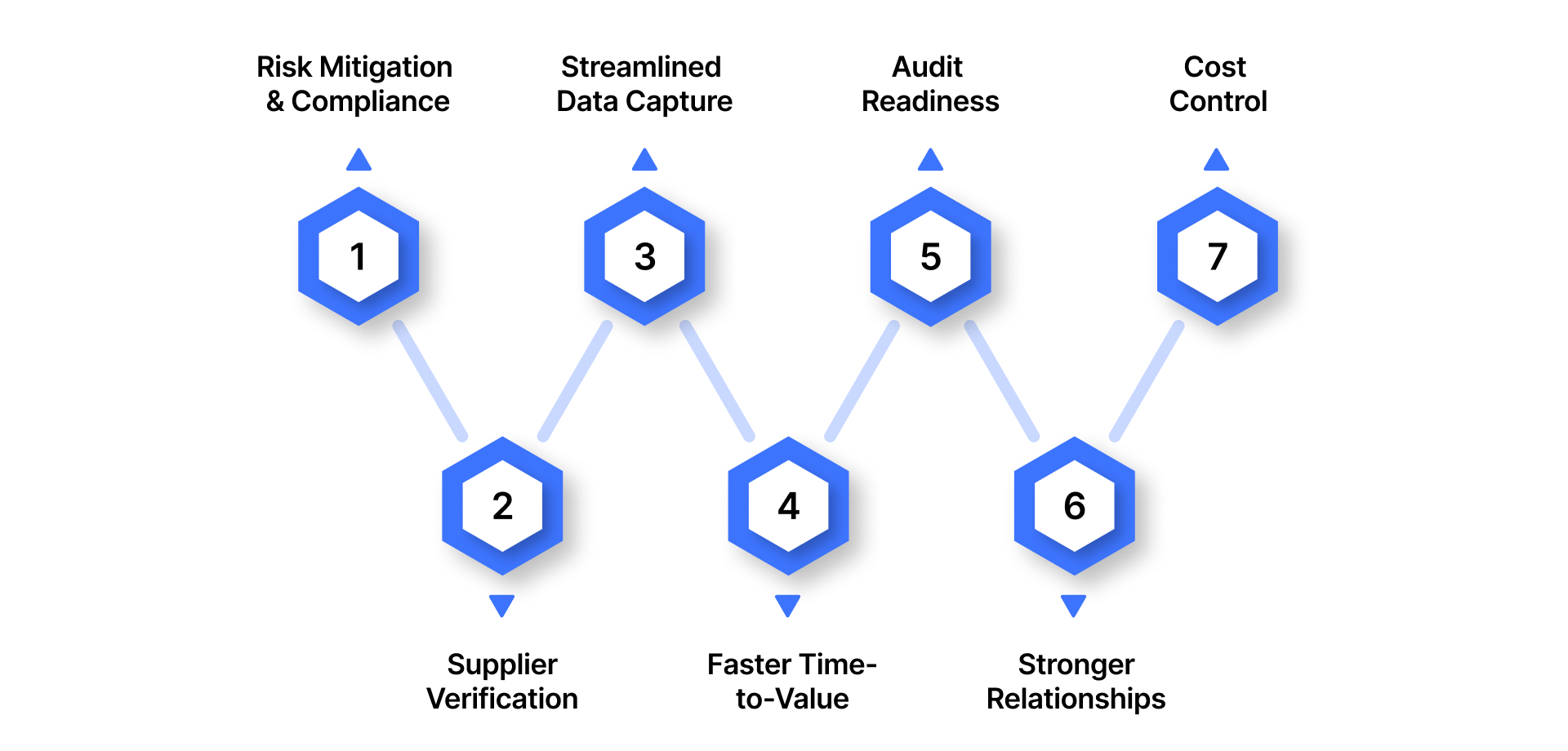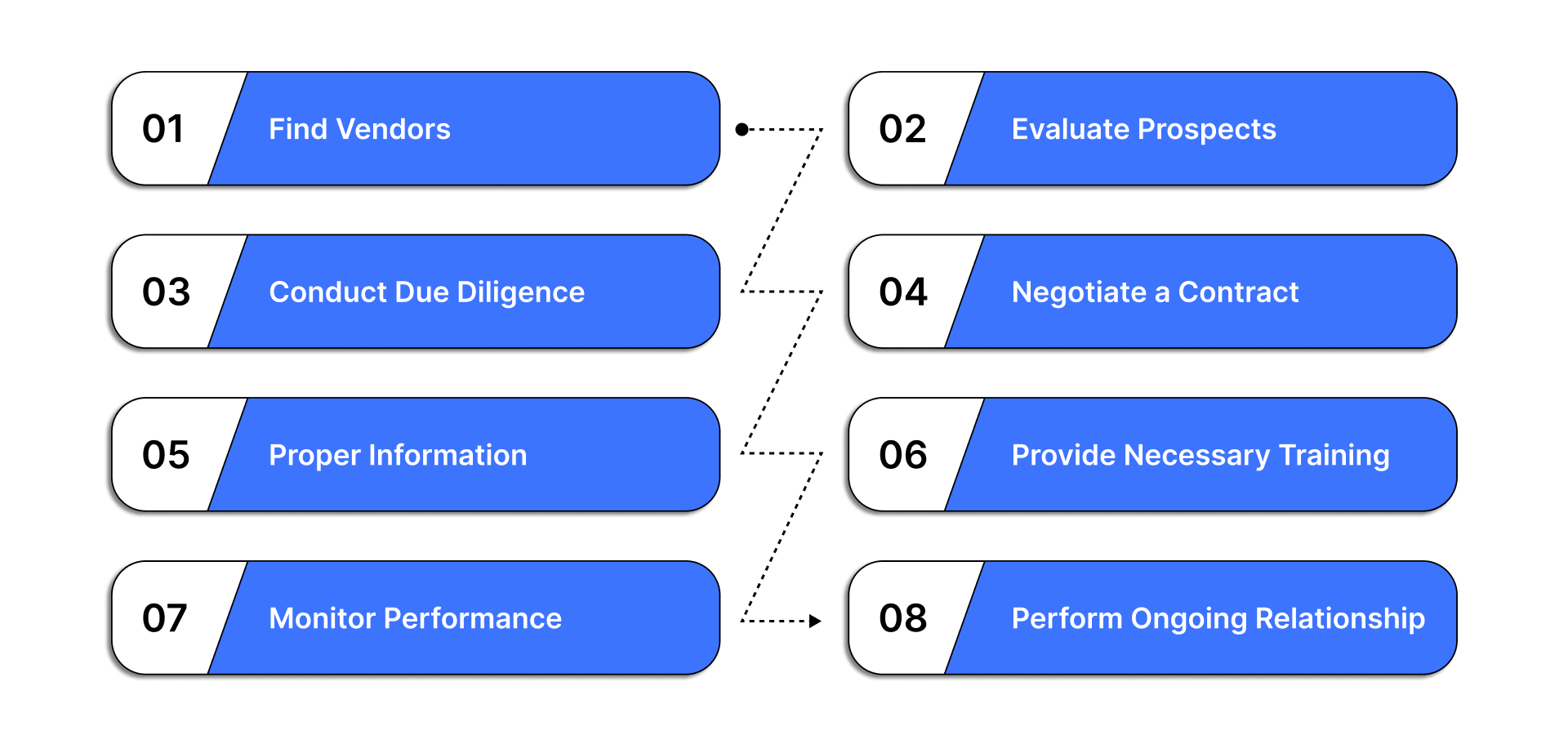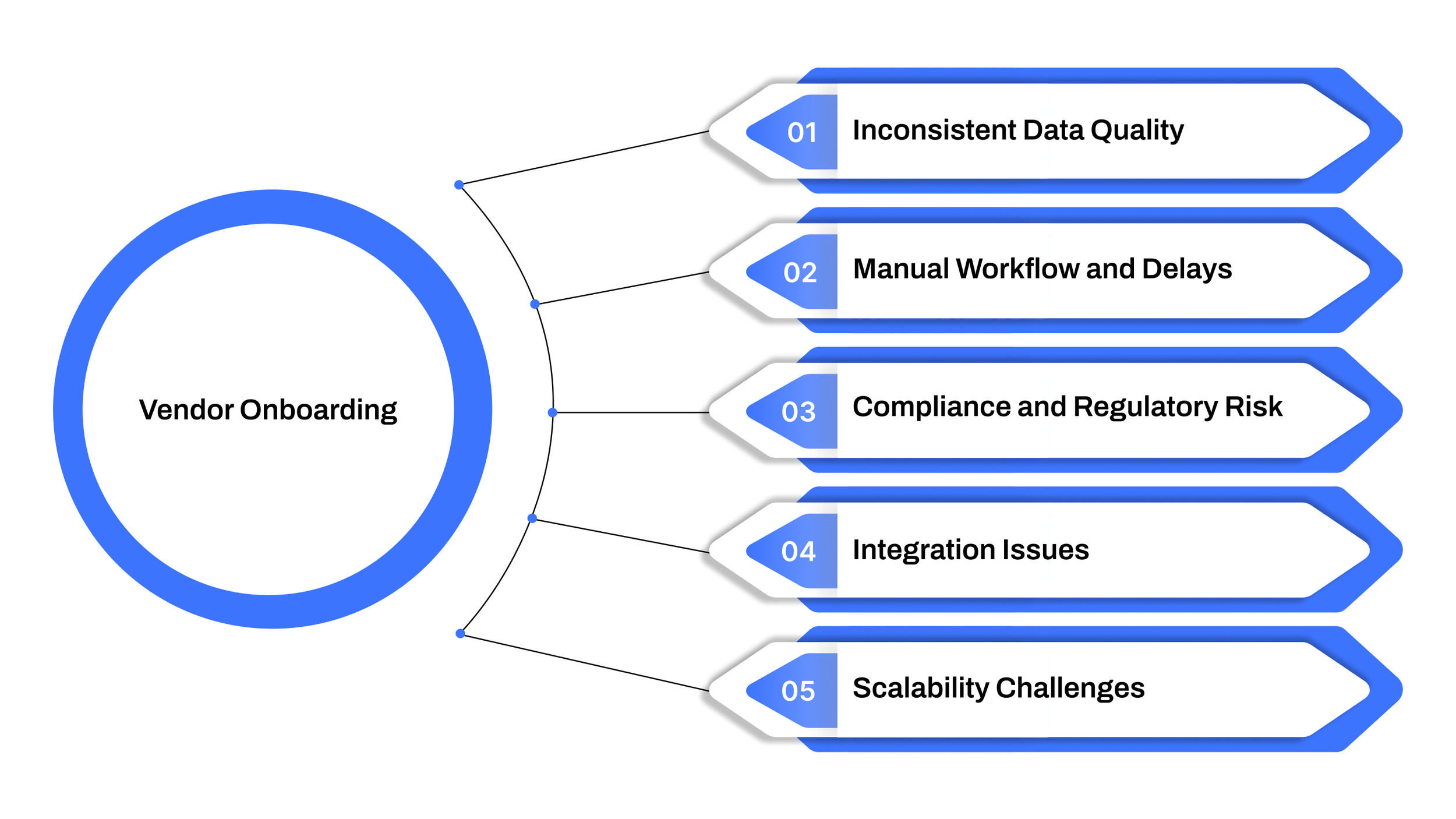Vendor Onboarding Process: Step-by-Step Guide and Tips
For any business that relies on third-party suppliers or service providers, smooth collaboration begins long before the first purchase order is raised. It starts with a structured vendor onboarding SOP, a systematic process that ensures new vendors are thoroughly evaluated, compliant, and aligned with company standards.
When done right, vendor onboarding goes beyond filling out forms or ticking off checklists. It creates a foundation of trust, transparency, and accountability between the buyer and the supplier. A strong onboarding framework not only speeds up procurement cycles but also mitigates risks such as compliance failures, data security issues, or supply chain disruptions.
This guide breaks down the vendor onboarding process step by step, explores best practices, and highlights common challenges, so your business can transform onboarding into a strategic advantage rather than an operational hurdle.
Before we dive in:
Vendor onboarding SOP ensures suppliers are vetted, compliant, and ready to collaborate.
Key challenges include poor data, compliance risks, delays, and scalability issues.
Automation, integration, and structured workflows make onboarding efficient.
Vendor risk management and a Trust Center strengthen security and trust in supplier ecosystems.
Auditive helps organizations transform onboarding into a scalable, compliance-first process.
What is Vendor Onboarding?
Vendor onboarding is the structured process of bringing a new supplier into an organization’s procurement system. At its core, it involves collecting and verifying essential information, conducting compliance and risk checks, and ensuring the vendor can meet required quality and operational standards. This process creates the foundation for a secure, efficient, and mutually beneficial partnership from the very beginning.
Sometimes referred to as the supplier onboarding process, vendor onboarding goes beyond paperwork, it’s about evaluating a vendor’s capabilities, aligning them with company policies, and integrating them seamlessly into your procurement and payment systems. From confirming tax and legal documentation to setting up workflows for purchase orders and invoicing, a well-designed vendor onboarding SOP ensures that every new supplier is both trustworthy and operationally ready.
Without this structured approach, businesses risk delays, compliance failures, or even reputational damage. With it, organizations can confidently assess, onboard, and collaborate with vendors who support their long-term goals.
Why Structured Vendor Onboarding Process is Important?
A structured vendor onboarding SOP sets the foundation for stronger supplier relationships and risk-free operations. Instead of treating onboarding as a checklist, organizations that systematize the process gain long-term advantages in compliance, performance, and cost efficiency.
Here’s why it matters:
Risk Mitigation & Compliance – Acts as the first line of defense against fraud, data errors, and contract misalignment while ensuring regulatory compliance.
Supplier Verification – Allows procurement teams to validate supplier credentials, assess ESG commitments, and confirm alignment with ethical standards.
Streamlined Data Capture – Standardizes supplier information across procurement systems, reducing friction and ensuring smooth integration.
Faster Time-to-Value – Helps suppliers align with internal processes, quality benchmarks, and KPIs from day one, accelerating collaboration.
Audit Readiness – Creates a transparent and well-documented process that simplifies regulatory audits and reporting requirements.
Stronger Relationships – Builds trust and promotes long-term supplier partnerships by setting clear expectations early.
Cost Control – Reduces untracked or maverick spending, improving financial oversight across procurement channels.
In short, a well-defined vendor onboarding SOP is not just about efficiency, it’s about protecting the organization while enabling suppliers to deliver maximum value from the very beginning.
Step-by-Step Guide to Vendor Onboarding Process
Vendor onboarding is more than just ticking off checklists, it’s about laying the foundation for a secure, efficient, and long-term business partnership. A strong process minimizes risks, ensures compliance, and builds mutual trust from day one.
Here’s a detailed breakdown of the 8 essential steps in the vendor onboarding journey:
Step 1: Find Vendors
The onboarding process begins with identifying potential suppliers who align with your business needs. This step is not only about availability, it’s about strategic selection.
Ways to find vendors include:
Industry networks and recommendations from peers.
Online research using supplier directories, marketplaces, or business registries.
Attending trade shows or industry conferences to connect directly with vendors.
Using procurement platforms for pre-vetted suppliers.
At this stage, the goal is to cast a wide net and create an initial shortlist of potential vendors worth evaluating further.
Step 2: Evaluate Prospects
Once you have a pool of candidates, the next step is to assess their suitability based on predefined criteria. Each organization’s evaluation parameters may vary, but typically include:
Reputation and reliability in the industry.
Quality of products/services offered.
Cost structures and pricing models.
Compliance readiness (licenses, certifications, etc.).
Scalability and capacity to meet your demand.
Cultural alignment with your organizational values.
This stage helps narrow down your options to vendors who aren’t just available, but truly capable of supporting your business goals.
Step 3: Conduct Due Diligence
Due diligence is a non-negotiable step to mitigate supplier risks. According to surveys, nearly 73% of organizations faced significant disruptions due to third-party risks in recent years, highlighting the importance of vetting suppliers thoroughly.
Must read: Third Party Risk Management Guidance
Key checks include:
Business legitimacy: Articles of Incorporation, Certificates of Good Standing, licenses, and Tax ID verification.
Financial stability: Reviewing credit scores or financial statements (especially for mission-critical suppliers).
Legal compliance: Ensuring they are not restricted by sanctions or regulatory red flags.
Reputation checks: References from current/past clients, online reviews, and industry feedback.
Subcontractor transparency: Knowing who else they rely on in their supply chain.
This phase ensures your organization is entering into agreements with credible, stable, and compliant vendors.
Step 4: Negotiate a Contract
With validated vendors in hand, it’s time to define the partnership terms through contracts. This is where expectations meet formal agreements.
Contracts usually outline:
Pricing and payment terms.
Delivery timelines and milestones.
Service-Level Agreements (SLAs) covering quality and responsiveness.
Termination clauses in case of non-performance.
Confidentiality and data protection measures.
Negotiations should be balanced and fair, ensuring your organization secures favorable terms while building trust and loyalty with the vendor. Overly aggressive negotiation can harm relationships before they even begin.
Step 5: Exchange the Proper Information
Once the contract is signed, both parties need to share critical business and operational information to integrate smoothly.
For your business:
Vendor details (legal name, Tax ID, registered address, bank details).
Contact points for billing, delivery, and issue escalation.
Compliance documents (if not already provided).
For the vendor:
Your internal payment setup and invoicing process.
Procurement system access and approval workflows.
Key personnel contacts for operations, procurement, and finance.
This stage ensures both sides are system-ready to start the partnership without delays.
Step 6: Provide Necessary Training
Smooth collaboration requires knowledge transfer. Both sides may need onboarding into each other’s systems and processes.
Examples:
Your internal staff may need training on vendor’s ordering or invoicing systems.
The vendor’s team may require access to your procurement platforms or ERP systems.
Both parties need clarity on communication protocols and escalation paths.
Training eliminates early misunderstandings and ensures seamless operational execution.
Step 7: Monitor Performance
Once operations begin, continuous monitoring helps track vendor reliability and performance. This can be done using a vendor scorecard with KPIs such as:
Lead time: Average days between order and delivery.
Accuracy: Percentage of error-free orders.
Fulfillment rate: Proportion of on-time and complete deliveries.
Quality levels: Percentage of items that meet quality checks.
Responsiveness: Average resolution time for complaints.
Performance monitoring provides quantifiable data to guide discussions, highlight risks, and foster improvement where needed.
Step 8: Perform Ongoing Relationship Management
Onboarding doesn’t end after the first transaction. Successful vendor relationships are nurtured continuously to maximize long-term benefits.
Effective vendor relationship management (VRM) includes:
Regular communication to share feedback and resolve issues proactively.
Joint process improvement initiatives to streamline workflows.
Incentives or recognition for consistent high performance.
Collaboration on innovation, working with vendors to explore new ideas or technologies.
A strong vendor relationship creates mutual trust, better terms, and priority service, helping your business thrive in a competitive market.
Also Read: Create Vendor Management Policy
While these steps create a solid foundation, manual vendor onboarding and risk assessment often leave blind spots. This is where Auditive steps in, empowering businesses with real-time vendor risk insights, automated due diligence, and trust management. By integrating vendor onboarding into a centralized Trust Center, organizations can reduce risks, streamline workflows, and ensure compliance without slowing down business.
Efficient Vendor Onboarding Best Practices
An effective vendor onboarding SOP is not just about speed; it’s about creating a repeatable process that balances efficiency with compliance. The right practices help organizations streamline supplier integration while ensuring risks are managed from the very first interaction.
Here are some proven strategies:
Learn more about: Understanding Vendors Definition Types Differences
1. Standardize workflows for consistency
Building a structured onboarding framework with templates, predefined checklists, and approval flows removes uncertainty. It ensures every vendor, whether local or global, is onboarded with the same level of scrutiny and clarity.
2. Use digital platforms for automation
Manual onboarding often leads to delays, errors, and missing documents. Centralized onboarding platforms simplify data collection, automate verification steps, and provide real-time visibility into vendor status, helping procurement teams save time and focus on strategic tasks.
3. Apply risk-based tiering models
Not all vendors carry the same level of risk. By classifying suppliers into categories such as low-, medium-, or high-risk, businesses can tailor the onboarding depth. This avoids unnecessary administrative work while ensuring critical vendors get the due diligence they deserve.
4. Involve legal teams early
Procurement and legal must work hand in hand. Involving legal experts during onboarding helps avoid last-minute contract disputes and ensures compliance requirements are clear from the start.
5. Regularly audit and refine the process
Business environments and regulations evolve quickly. Conducting periodic audits allows companies to identify bottlenecks, remove redundant steps, and keep the onboarding SOP aligned with industry standards.
Efficient vendor onboarding isn’t just about operational speed, it’s about building resilient supplier partnerships from day one. And this is where platforms like Auditive step in, enabling businesses to strengthen supplier management through smarter automation, risk intelligence, and compliance visibility.
Common Challenges in Vendor Onboarding
Even the most carefully structured vendor onboarding SOP can stumble when real-world complexities enter the picture. Procurement leaders often discover that despite having processes in place, operational inefficiencies, compliance gaps, and scalability issues creep in. Recognizing these hurdles early is critical for creating supplier ecosystems that are both resilient and future-proof.
Also read: Effective Vendor Onboarding Documents
1. Inconsistent Data Quality
More than half (53%) of procurement professionals report supplier data issues, ranging from outdated records to manual entry errors. Poor data quality not only slows down onboarding but also compromises compliance checks and decision-making. Automated validation systems and centralized supplier databases can solve this challenge, ensuring cleaner, more reliable vendor information.
2. Manual Workflow and Delays
Traditional onboarding methods, spreadsheet tracking and endless email chains, stretch timelines to 30 days or more. Such inefficiencies delay supplier activation and, by extension, slow down procurement cycles. Automating repetitive tasks and adopting digital onboarding tools significantly cut down these delays, enabling suppliers to get started faster.
3. Compliance and Regulatory Risk
Operating across diverse regulatory landscapes without standardized compliance checks exposes businesses to costly legal penalties and reputational damage. Embedding automated compliance verification (for certifications, financial stability, and regulatory requirements) into the onboarding process helps organizations mitigate risks before they escalate.
4. Integration Issues with Existing Platforms
If vendor systems don’t align with your existing ERP or procurement platforms, data silos and workflow disruptions are inevitable. API-driven integrations and early collaboration between IT and procurement teams prevent these bottlenecks, ensuring seamless vendor connectivity.
5. Scalability Challenges
As businesses grow, manual onboarding processes struggle to keep pace. Onboarding hundreds or thousands of suppliers using people-heavy processes creates roadblocks and higher costs. Scalable solutions such as self-service portals, digital decision workflows, and automated approvals allow organizations to expand supplier networks without stretching resources thin.
Tackling these challenges proactively requires thoughtful investments, process redesign, and a commitment to data-driven decision-making. This is where intelligent platforms like Auditive make a difference, helping businesses streamline onboarding, ensure compliance, and scale vendor ecosystems with confidence.
How Auditive Enhances Vendor Onboarding
Vendor onboarding isn’t just about adding a supplier to your list—it’s about building a foundation of trust, compliance, and operational efficiency. This is where Auditive empowers procurement leaders to reimagine the onboarding journey.
With Auditive, businesses can:
Automate Data Validation – Ensure accurate, up-to-date supplier records with smart verification tools that eliminate manual errors.
Simplify Compliance – Embed automated checks for certifications, financials, and regulatory requirements to reduce compliance risk across global markets.
Accelerate Onboarding – Replace time-consuming spreadsheets and email workflows with digital-first, automated processes that shorten supplier activation timelines.
Enable Seamless Integration – Connect vendor data smoothly with existing ERP, procurement, and finance systems through flexible APIs.
Scale with Confidence – Using self-service portals and decision workflows that make it easy to onboard hundreds—or thousands—of vendors without added strain.
Auditive’s focus on vendor risk management ensures organizations not only onboard efficiently but also safeguard against hidden risks. And with its built-in Trust Center, businesses gain transparency, control, and peace of mind—knowing their supplier ecosystem is secure and scalable.
By embedding these capabilities, Auditive turns vendor onboarding from a compliance-heavy task into a competitive advantage.
Final Thoughts
A structured vendor onboarding SOP isn’t just about ticking procedural boxes—it’s about enabling trust, compliance, and long-term supplier relationships. When done right, onboarding creates a foundation for efficiency, reduces regulatory risks, and strengthens operational resilience.
This is where vendor risk management becomes vital. By actively monitoring compliance, integrating verification checks, and ensuring consistent data quality, businesses can avoid costly disruptions. And with a Trust Center, organizations gain visibility and confidence in every vendor relationship, ensuring that partnerships are secure, compliant, and scalable.
If you want to move beyond manual inefficiencies and make vendor onboarding a driver of business success, Auditive is your trusted partner. With advanced automation, compliance-driven workflows, and risk intelligence, Auditive empowers you to transform onboarding into a competitive advantage.
Ready to streamline vendor onboarding and build a resilient supplier ecosystem?
Explore how Auditive can help today.
FAQs
1. What is a vendor onboarding SOP?
A vendor onboarding SOP (Standard Operating Procedure) is a structured process that guides organizations in evaluating, verifying, and integrating new suppliers into their procurement ecosystem.
2. Why is vendor onboarding so important?
It ensures suppliers meet compliance, risk, and performance standards, reducing disruptions and protecting businesses from regulatory or reputational harm.
3. What are the most common challenges in vendor onboarding?
Poor data quality, manual delays, compliance risks, integration issues, and scalability challenges are the most common obstacles.
4. How can technology improve vendor onboarding?
Automation, API integrations, digital workflows, and self-service portals help reduce delays, improve compliance, and enable large-scale onboarding efficiently.
5. How does Auditive support vendor onboarding?
Auditive provides automation, compliance monitoring, vendor risk management, and a Trust Center that ensures secure, transparent, and scalable onboarding.







